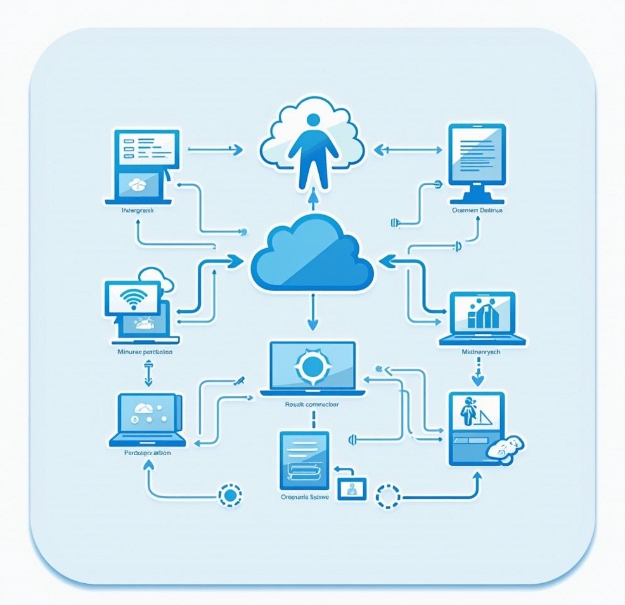Cost Management in Cloud Computing: How to Reduce Cloud Resource Expenses
- latest articles
- 1.DApp Development & Customization: Merging Diverse Market Needs with User Experience 2.Analysis of the Core Technical System in DApp Project Development 3.How to achieve cross-chain interoperability in Web3 projects? 4.How does the tokenization of points reconstruct the e-commerce ecosystem? 5.How to Set and Track Data Metrics for a Points Mall? 6.What is DApp Development? Core Concepts and Technical Analysis 7.Inventory of commonly used Web3 development tools and usage tips 8.Development of a Distribution System Integrated with Social E-commerce 9.Six Key Steps for Businesses to Build a Points Mall System 10.What is DApp Development? A Comprehensive Guide from Concept to Implementation
- Popular Articles
- 1.Future Trends and Technology Predictions for APP Development in 2025 2.Analysis of the DeFi Ecosystem: How Developers Can Participate in Decentralized Finance Innovation 3.From Zero to One: How PI Mall Revolutionizes the Traditional E-commerce Model 4.DAPP Development | Best Practices for Professional Customization and Rapid Launch 5.Recommended by the Web3 developer community: the most noteworthy forums and resources 6.From Cloud Computing to Computing Power Leasing: Building a Flexible and Scalable Computing Resource Platform 7.How to Develop a Successful Douyin Mini Program: Technical Architecture and Best Practices 8.Shared Bike System APP: The Convenient Choice in the Era of Smart Travel 9.How to Create a Successful Dating App: From Needs Analysis to User Experience Design 10.From Design to Development: The Complete Process of Bringing an APP Idea to Life
With the rapid advancement of information technology, cloud computing, as a new IT service model, has been widely adopted across various industries. Enterprises can rent infrastructure, platforms, and software services through cloud computing platforms without significant investment in hardware and management resources. However, while cloud computing offers flexibility and scalability, improper resource management can lead to continuously rising cloud service costs. Therefore, effectively controlling and reducing cloud resource expenses while ensuring business needs has become a critical issue that enterprises must address when adopting cloud computing.
Cost Components of Cloud Computing
Before delving into cloud computing cost management, it is essential to understand its cost components. Cloud computing expenses typically consist of the following main aspects:
Computing Resources: Cloud service providers usually charge on-demand, with enterprises paying based on computing requirements (such as CPU, memory, etc.). Higher usage of computing resources results in higher costs.
Storage Resources: Cloud platforms offer various types of storage services, with costs typically calculated based on storage space and duration. The scale of data storage, frequency of read/write operations, and storage type all affect the final cost.
Data Transfer: When data flows out from the cloud platform to the internet or other platforms, data transfer fees are usually incurred. Large volumes of data transfer and frequent cross-regional traffic are often hidden cost sources.
Network Bandwidth: For applications requiring high bandwidth support, such as video streaming and data backups, network bandwidth costs must also be considered.
Software Services: Including SaaS, PaaS, and other cloud services, typically billed on a subscription or pay-as-you-go basis.
Other Additional Services: Such as security, backup, monitoring, etc. These costs are sometimes overlooked but can accumulate over time, increasing overall expenses.

Challenges in Cloud Computing Cost Management
In cloud computing resource management, enterprises may face the following cost management challenges:
Uneven Resource Usage: The flexibility of cloud platforms allows enterprises to quickly scale resources up or down, but without proper management, they may incur high costs due to over-provisioning or underutilization of resources.
Misuse of Automation and Elastic Computing: Although cloud platforms offer automated scaling and elastic computing features, without reasonable monitoring and threshold settings, these functions can lead to unnecessary resource waste, especially in scenarios with significant demand fluctuations.
Complex Billing Models: Cloud service providers often use various complex billing models, including pay-per-hour, pay-per-usage, and performance-based billing. If enterprises fail to fully understand these models, unexpected expenses may arise.
Cross-Platform Management Difficulty: Many enterprises use multiple cloud service platforms, and the resource management and billing methods differ across platforms, increasing the difficulty of cost control.
How to Reduce Cloud Resource Expenses
Optimize Resource Allocation
Enterprises first need to conduct a detailed analysis of their cloud computing resources to understand the usage of different services. Through monitoring and analysis tools, identify instances of over-provisioning or wastage. For example, some virtual machine instances may have higher performance than actually needed, or certain storage resources may not be fully utilized. By adjusting instance types, deactivating unnecessary resources, or streamlining storage configurations, enterprises can significantly reduce unnecessary expenses.
Implement Automated Resource Management
Cloud platforms provide automated scaling features that dynamically adjust resource scale based on business needs. Enterprises can set appropriate thresholds to automatically start and stop resources, avoiding continued consumption of computing resources during low-demand periods. Additionally, leveraging automation tools can help regularly check and optimize resource configurations, preventing oversights and wastage from manual management.
Choose the Right Pricing Plan
Major cloud service providers like AWS, Azure, and Google Cloud offer different pricing models. Enterprises should select the most suitable pricing plan based on their business needs. For instance, short-term projects may opt for pay-as-you-go, while long-term projects may benefit from prepaid or reserved instances. Through detailed cost calculations and evaluations, the most cost-effective solution can be identified.
Optimize Storage Strategies
Storage costs are a significant component of cloud computing expenses. Enterprises can choose different types of storage services based on data access frequency. For example, cold data can be stored in low-cost archival storage, while frequently accessed data can use high-performance SSD storage. Additionally, regularly cleaning up unused data and reducing redundant data storage are effective ways to lower storage costs.
Reduce Data Transfer Costs
Data transfer costs are often overlooked by many enterprises. Cross-regional data transfers, in particular, usually incur additional high fees. To reduce these expenses, enterprises should deploy computing and storage resources as close as possible to data sources, minimizing cross-regional data transfers. If possible, leveraging the cloud platform's CDN (Content Delivery Network) service can reduce network bandwidth usage and accelerate data transfer.
Continuously Monitor and Analyze Costs
The complexity of cloud computing environments makes cost management a dynamic process. Enterprises should regularly monitor and analyze cloud computing resources, using cost analysis tools provided by cloud service providers or third-party tools to view and evaluate expenses in real-time. These tools can help identify unnecessary costs and enable targeted optimizations. For example, AWS's "Cost Explorer" tool and Azure's "Cost Management + Billing" feature can assist enterprises in comprehensively monitoring and optimizing costs.
Leverage Cloud Provider Discount Programs
Most cloud service providers offer discount programs, such as long-term subscription discounts, reserved instances, and savings plans. Enterprises can utilize these programs to further reduce cloud computing costs. For instance, AWS's "Savings Plans" help enterprises enjoy discounts over a committed period, while Azure's "prepaid discounts" allow purchasing resources at reduced prices.

Case Study Analysis
By analyzing the cloud computing cost management practices of some enterprises, we can derive valuable insights. Below is a case study demonstrating significant results through cloud computing cost optimization:
Case: Cloud Resource Cost Optimization for an Online Education Platform
An online education platform used cloud computing to support its video course playback, user data storage, and real-time interaction features. Initially, due to significant demand fluctuations, the platform required substantial computing resources during peak periods, while resources remained idle during off-peak times. Through analysis and resource allocation adjustments, the platform implemented the following measures:
Combined On-Demand and Reserved Instances: During peak periods, the platform used on-demand instances; during off-peak periods, it opted for reserved instances to ensure continuous optimization of resource usage.
Optimized Storage Tiers: Migrated infrequently accessed data to low-cost storage and used cold storage for archiving.
Leveraged Automated Scaling: The platform automatically scaled resources up or down based on access fluctuations, avoiding resource wastage.
Reduced Data Transfer Costs via Regional Optimization: Migrated some computing resources to regions with higher user concentration, thereby reducing data transfer costs.
These measures reduced the platform's cloud computing costs by approximately 30%, while ensuring service stability and user experience.
Summary
Cost management in cloud computing is a crucial aspect that enterprises must prioritize when using cloud resources. By optimizing resource allocation, implementing automated management, selecting appropriate pricing plans, optimizing storage strategies, and reducing data transfer costs, enterprises can effectively control cloud computing expenses and enhance resource utilization efficiency. Additionally, continuous monitoring and analysis will help enterprises promptly identify potential wastage and make adjustments. Ultimately, through meticulous cost management, enterprises can not only reduce cloud computing expenses but also gain a competitive economic advantage in the market.
-

Applications and Challenges of Cloud Computing in the Internet of Things (IoT)
With the continuous advancement of information technology, cloud computing and t···
-

Integration of Cloud Computing and Artificial Intelligence: Enhancing Intelligent Applications
With the rapid advancement of technology, cloud computing and artificial intelli···
-

Data Security and Privacy Protection in Cloud Computing Applications
With the continuous advancement of information technology and the rapid developm···

 Blockchain
Blockchain










